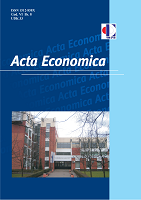ИСКУСТВА САД У РАЗВОЈУ МАЊЕ РАЗВИЈЕНИХ ТЕРИТОРИЈА ПРИМЕНОМ МЕРА РУРАЛНЕ ПОЛИТИКЕ - СТАЊЕ И ТЕНДЕНЦИЈЕ
USA EXPERIENCE IN DEVELOPMENT OF THE LESS DEVELOPED TERRITORIES BY RURAL POLICY MEASURES APPLICATION– SITUATION AND TRENDS
Author(s): Goran PopovićSubject(s): National Economy, Economic policy, Political economy, Rural and urban sociology, Economic development, Socio-Economic Research
Published by: Економски факултет Универзитета у Бањој Луци
Keywords: Development; rural development; fundamental research; institutional dimensions; american model; market liberalization; non-loyal; competitiveness;
Summary/Abstract: The United States are performing an authentic policy in development of the less developed areas. It has a character of a highly centralised activity led by the US Department of Agriculture (USDA). Along with that, the practice, programmes, and legislation have established the centres of rural development on the lower, particularly local, levels. As in all other spheres of social life, the Americans have strongly financially supported fundamental and other research in the rural development sphere. Through these, global directions and solutions have been sought for future changes and long-term trends. However, we can already state that the growing disparity of income, investment in the infrastructure and de-balanced structural relationships between urban and rural are good reasons for creating concrete initiatives and a development strategy for rural economy throughout America. The respective States individually develop various rural programmes while USDA supervises assists and coordinates development process on the principles. Rural Development Councils (SDRC) located in each State have profiled seven institutional dimensions of the rural development policy. Urban America has accepted the fact that it must invest into the rural part, in order to reduce a development gap make a long-term balance in unfavourable balances of intra-government transfers, rationally invest into the infrastructure and prevent unplanned demographical inflows into the cities. However, in comparison with the European model that, by means of expensive macroeconomic projects fundamentally changes the existing social and economic structure, American model is still subordinate to a large farm production. While EU prefers multifunctionality of development in the rural areas, the States are still limited with the factors imposed by big capital. Nevertheless, both Americans and Europeans have been putting efforts in better understanding and harmonisation of the rural development policies, particularly after market liberalisation within STO and Uruguay round. EU has been trying to place subsidisation within the rural economy framework, which would ensure a more favourable position within STO, while the States successfully resist to such principle, since the classic agriculture position is still more dominant than rural economy complex. Thus the Americans, in their implementation of the authentic rural policy measures, still oppose to the European model the aim of which is to, along with deep structural changes, “wrap” the concept of rural economy “into a roll” of non-loyal subsidies and intensification of agricultural production . With their present approach, the States are ensuring progress in the rural sector development, maintaining, on the other side, their competitiveness and dominant position in the world agricultural products market.
Journal: Acta Economica
- Issue Year: 3/2003
- Issue No: 3
- Page Range: 49-68
- Page Count: 20
- Language: Bosnian, Croatian, Serbian

